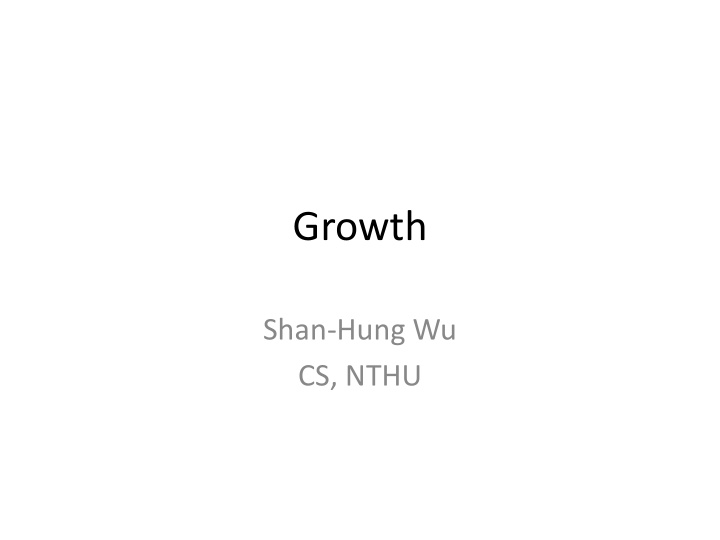



Growth Shan-Hung Wu CS, NTHU
Default Alive or Dead ? by Paul Graham • Assuming – An initial fund – Fixed expenses – Linear/predictable revenue growth • Can you make it to profitability before running out of your money? 2
Startup Growth Calculator 3
What’s Next? • Default alive : – Ambitious new things – Scale phase – Raise more fund (O) • Default dead : – Raise more fund (X) – To fix growth & revenue – at no (or little) more expense 4
Outline • Metric • Actions & Psychology ? 5 Whys ? 5
Vanity Metrics • #shares • #likes • #reviews 6
Virality • Inherent virality : a function of use, e.g., Messenger • Artificial virality : forced, often built into a reward system • Word-of-mouth virality : conversation of satisfied users, product-independent 7
KPIs • Viral coefficient • Viral cycle time 8
Viral Coefficient • The number of new users/customers that each existing user/customer successfully converts Existing users 2,000 Total invitations 5,000 Invitation rate 2.5 Downloads 1,000 Acceptance rate 0.2 Viral coefficient 0.5 • VC = IR * AR – How to increase IR? – How to increase AR? 9
Viral Cycle Time • Avg. time required for each conversion – Time to invite + time to accept • Assume 2k initial users and VC = 0.5, after 20 days: – 115K users if cycle time = 2 days – 6.6M users if cycle time = 1 day • How to reduce time to invite? • How to reduce time to accept? 10
More Metrics • Track user actions that drive virality – E.g., #shares, time-to-share, #likes, etc. • Watch the word-of-mouth (qualitative) – Inject hashtags into shared text – Monitor hashtags using tools like TweetDeck 11
Line in the Sand • You viral coefficient will saturate – Depending on how “tight” between users • Generally, VC > 1 means you are “viral” – Grow without much marketing/PR budget 12
Goals for Growth • If you are viral, your growth will looks like a Bass diffusion curve: – Usually, the initial flat period is much longer • Y-Combinator teams: 5% per week 13
Outline • Metric • Actions & Psychology ? 5 Whys VC, VCT 14
Marketing is about selling more stuff to more people more often for more money more efficiently. - Sergio Zyman, What to optimize first? CMO, Coca-Cola 15
Stop the Leaky Bucket ! • Reducing churn rate is the first step of growth • User churn rate ≠ customer churn rate – Track both 16
Why Is Churn Rate So Important? • May define an upper bound of your business – E.g., customer churn rate over ARR • Usually, re- engagement is more cost-effective than acquisition – E.g., via tailored emails 17
Turn Your Happy Customers into Sales • How? 18
Ratings & Reviews • Shown on your (app) landing page • Very important – Humans, when having little clue, tends to believe social proof • Ranking factors: – App Store: #ratings > #installs > trends > avg. rating – Google Play: #ratings > #installs > avg. rating > trends 19
How to Get Positive Ratings/Reviews? • Ask users to rate at right time, with right pattern – “Like” à rate – “Dislike” à feedback – when users are happy – and not interrupted “Ask Later” “Don’t Show Again” 20
Then? • There are many Growth Hacking books… 21
Common Selling Tactics • Halo effect • Quality comes with the price ($1 à $2) • Contrast principle • And many more… • Q: How to tell your mon you failed a class? • Based on stereotypes • … and “fast thinking” shortcuts 22
6 Psychological Principles • Reciprocation • Consistency • Social proof • Liking • Authority • Scarcity by Robert B. Cialdini 23
Reciprocation • Shortcut: we should try to repay in kind, what another person has provided us – Tactics: free samples • Reciprocal concession: make a large request first. After refusal, make second as concession – Leverages the contrast principle – Tactics: down selling • Which one to sell first? Expensive or cheap ones? • Flora? 24
Commitment & Consistency • Shortcut: after making a commitment, we behave consistently with it – Tactics: “How are you doing?” or “Sign here!” • Pressures: – Personal – Interpersonal (for public commitment) • Has long-term effect on one’s self-image – E.g., US PoWs start from “US is not perfect” • Flora? 25
Social Proof • Shortcut: we view a behavior as correct when seeing others like us doing it – Tactics: canned laughter, seed tips • Works particularly well in unknown situations • Selling “Price” feature in Flora? 26
Liking • Shortcut: we are more likely to like something that relates to what we already like – Tactics: Cars with hot girls • What cause liking? – Physical attractiveness (halo effect) – Similarity – Compliments – Contact and cooperation – Conditioning and association (Ivan Pavlov’s dog) • Flora? 27
Authority • Shortcut: We obey authorities mindlessly in isolation instead of seeing the situation as a whole – Tactics: fake doctors in ads, “according to research” • We are vulnerable to symbols of an authority – Titles, clothes, accessories, etc. • People, when asked about it, underestimate this effect. • Flora? 28
Scarcity • Shortcut: we believe that things that are difficult to own are usually better easier ones – Tactics: “limited offer,” “only today,” – Counterexamples: “Romeo and Juliet,” “Internet censoring” • Afraid of loss • Scarcity + rivalry – Tactics: auctions, online biddings • Flora? 29
Which Works Better? • US? – Reciprocation • Germany? – Commitment & Consistency • Spanish? – Liking • Asian? – Authority 30
Bonus • Your MVP should be designed to include – Retention engine – Revenue engine – Growth engine • Design your growth engine • Make it as part of your final presentation to get (at most) 10% bonus 31
Recommend
More recommend